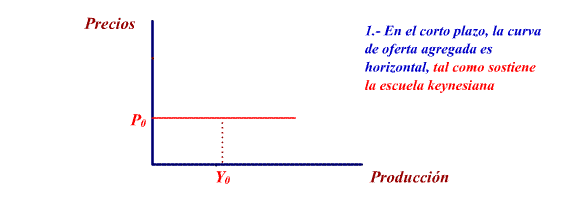Economic Theories
The two main lines of thought in the study of
Macro Economics have been the
Classical School and the Keynesian
school. As a result of these schools, new
tendencies have arisen.
The main difference between the schools is their
model for the aggregate offer
curve:
As the Classical School focus on
the long term, the curve is vertical because the production
of the companies is determined by the level of full employment
(it is always produced in full performance).
As the Keynesian school focuses more
on the behaviour of the economy in the short term, the offer
curve is horizontal.
We are now going to look at other characteristics
that differentiate the two
Schools:
a) Classical School
Perfect
Competence in all of the markets.
Flexible
prices on the rise and fall, including salaries,
which allows all of the markets (goods and services, money and
work, etc) to always be in equilibrium (if there isn't enought
demand or offer prices will change so that there is a balance
in the market).
The work
market is always in a situation of full employment. Unemployment
does not exist, unemployment that may sometimes exist is of
a frictional character (due to the time people take to find
a job which is in keeping with training) or voluntary (people
that do not want to accept a salary which the market offers
them).
The companies
offered production is determined by the level of full employment
(through the function of production).
Therefore, offer controls demand.
The offer curve is vertical and it determines the level of balanced
production: variations in demand
produce variations in prices.
The monetary
policy is inefficient (money neutrality): variations
in the monetary offer only effect the level of prices, without
having any effect on the real variables (demanded quantity,
balanced production, salaries, etc, once the effect of the prices
is refined).
Fiscal policy
doesn't count as the economy is always in a situation
of full employment, therefore these measures, in the end, only
translate in rising prices. In short, the State should not interfere
in the flow of the economy.
This model is especially good
for explaining the long term.
b) Keynesian School
Perfect
competence in the goods market is not always a good sign for
the work market due to the power of the syndicates (that demand
salaries decrease when there is unemployment).
The inflexibility of falling salaries
in the short term, can ensure the work market doesn't find balance
and can cause involuntary unemployment (in the Classical model
when these situations arose wages decreased and unemployment
disappeared, in the Keynesian model this doesn't happen).
The production offered by companies
tries to cover the demanded quantity, therefore, the demanded
quantity determines the level of economic activity, and with
it the level of employment.
Money in the short term can effect
the level of production as the economy is not always in a situation
of full employment. The monetary policy can have positive effects.
The fiscal
policy can be efficient in the short term to try and relaunch
a stagnant economy. In short, the role of the State is sometimes
necessary.
The Keynesian model is adequate
in the short term.
c) Neoclassical Synthesis Model
This school, as we have already seen, likes Keynes theories
(centred in the behaviour
of the economy in the short term) with
the Classical school theory (centred in
its behaviour in the long
term).
This model mantains that in the short
term, the prices and salaries are rigid (as the Keynesian model
maintains), but if we analyse a wider time frame the prices
and salaries start to slowly adjust. In the long term, the prices
are totally flexible (Classical model).

According to this model:
In the short term, the Keynesian
Model theories are valid.
In the long term, the Classical
Model theories are valid.
|

